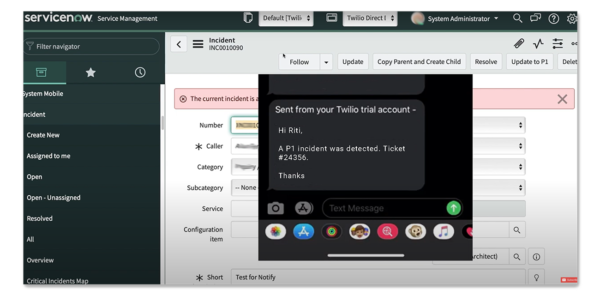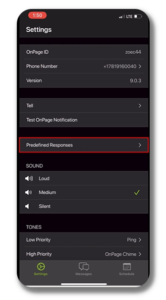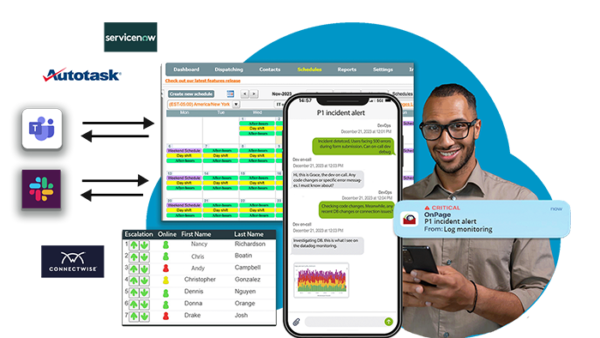Problems with ServiceNow and Twilio

Rethinking IT Management – Introduction
We live in a time where immediate communication of critical incidents is vital for maintaining continuous service availability. As companies strive to enhance their IT service management practices, many integrate technologies like Interactive Voice Response (IVR) into their service delivery frameworks.
However, this approach may not always be the most effective. In this blog, we’ll explore why integrating ServiceNow’s ITSM tool with Twilio IVR for critical notifications might not be the optimal strategy. We’ll also discuss the potential downsides of this integration and highlight how you can maximize the benefits of ServiceNow by utilizing OnPage’s alerting and incident management solution.
How Developers are Using ServiceNow and Twilio IVR

Try OnPage for FREE! Request an enterprise free trial.
ServiceNow and Twilio are powerful tools that, when combined, aim to streamline IT service management and enhance communication channels. Developers and IT teams often integrate these platforms to create a more responsive and automated workflow for handling critical incidents.
ServiceNow, as an ITSM tool, is critical in managing incidents, service requests, problems and changes. Incidents detected by monitoring systems or logged by help desk professionals are organized, managed, categorized and prioritized within ServiceNow ITSM. Workflows can be be configured to automatically create incident tickets, applying predefined rules for categorization and prioritization.
Twilio’s telephony and IVR system can be set up to initiate phone calls, notifying relevant personnel about incidents. This is particularly useful when immediate human intervention is required. Developers utilize Twilio’s telephony services and ServiceNow Notify to route tickets to on-call IT staff via SMS and telephone calls.
While this method may appear cost-effective, it often undermines the goal of creating a responsive incident management practice due to its lack of reliability and absence of guaranteed response from incident responders. In the next section, we’ll discuss why this method fails to deliver a dependable incident response and explore more effective alternatives.
Challenges with the Integration
While integrating ServiceNow ITSM and Twilio telephony services can create a cost-effective workflow for connecting incidents to responders, it falls short in several critical areas:
Lack of Persistent Alerting
This integration is particularly ineffective for after-hours when on-call responders need to be reliably woken up to respond to incidents when an incident is logged into ServiceNow. Although ServiceNow Notify and Twilio can send notifications via SMS and phone calls, these channels often fail to capture the responder’s attention. They are neither loud enough nor persistent, meaning they do not repeat until the responder acknowledges the alert, making them ineffective for urgent, after-hours situations.
Inability to override/bypass DND and silent modes
A significant drawback of this integration is its failure to bypass Do Not Disturb (DND) and silent mode settings on phones. Many people put their phones in these modes to avoid disturbances during work or sleep. This inability to override these settings means that critical alerts may go unnoticed, defeating the purpose of having a phone/SMS alerting channel in the first place.
Lack of Time-Stamped Read Receipts
Another critical issue is the absence of detailed read receipts. While Twilio’s SMS functionality might provide information on when a message was sent, it often lacks insights into when the message was read by the responder. Without a clear audit trail showing when alerts were delivered, read, and responded to, there is less transparency and accountability. This gap can lead to uncomfortable situations where an incident responder may claim they did receive an alert, further complicating incident management.
These challenges underscore significant shortcomings in the integration of ServiceNow ITSM with Twilio telephony services, making it an unreliable solution for effective incident management. In the next section, we will explore a reliable alternative to ensure timely and efficient responses to critical incidents.
Try OnPage for FREE! Request an enterprise free trial.
OnPage as a Solution
To overcome the challenges posed by the integration of ServiceNow ITSM with Twilio telephony services, OnPage presents a robust alternative that ensures reliable and efficient incident management. Here’s how OnPage addresses each shortcoming:
Persistent Alerting Mechanism:

OnPage excels with its persistent alerting system, designed to ensure that critical alerts are not missed. Unlike SMS and phone calls that may be ignored or fail to capture attention, OnPage push notifications are persistent, continuously repeating until acknowledged. This feature is crucial for waking up on-call responders after hours, ensuring they respond promptly to incidents.
Intuitive On-Call Schedules and Escalations:

OnPage offers an intuitive interface for managing on-call schedules and escalations. With OnPage, you can easily create and manage schedules to ensure that the right people are alerted at the right times. Its escalation policies ensure that if a primary responder does not acknowledge the alert, it will automatically escalate to the next available person, guaranteeing that no critical alert goes unattended.
Ability to Override Silent and DND Modes:
One of OnPage’s standout features is its ability to override Do Not Disturb (DND) and silent mode settings on mobile devices. This capability ensures that critical alerts penetrate through these settings, guaranteeing that responders are notified regardless of their phone’s status, thereby eliminating the risk of missed alerts due to phone settings.
Time-Stamped Audit Trail:

OnPage provides a comprehensive, time-stamped audit trail for all alerts. This feature allows for complete transparency and accountability, showing exactly when an alert was sent, when it was read, and when it was responded to. This detailed audit trail ensures that there is a clear record of all actions taken, enhancing the accountability of responders and providing valuable insights for continuous improvement of incident management processes.
In essence, OnPage addresses key limitations of ServiceNow and Twilio integration, offering a more reliable, efficient, and accountable solution for incident management. Its persistent alerting, intuitive scheduling and escalation, capability to override phone settings, and detailed audit trails make it an indispensable tool for ensuring that critical incidents are managed effectively and promptly after hours.






